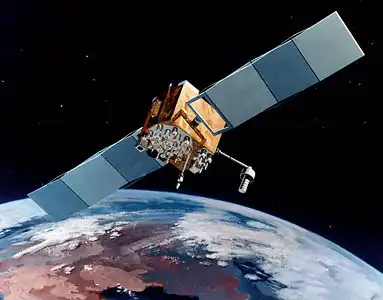 A Block IIF GPS satellite | |
| Mission type | Navigation |
|---|---|
| Operator | US Air Force |
| COSPAR ID | 2012-053A[1] |
| SATCAT no. | 38833[1] |
| Mission duration | 12 years (planned) |
| Spacecraft properties | |
| Spacecraft | GPS SVN-65 (IIF-3) |
| Spacecraft type | GPS Block IIF |
| Manufacturer | Boeing |
| Launch mass | 1,630 kilograms (3,590 lb)[2] |
| Start of mission | |
| Launch date | 4 October 2012, 12:10 UTC |
| Rocket | Delta IV-M+(4,2), D361[3] |
| Launch site | Cape Canaveral SLC-37B[3] |
| Contractor | ULA |
| Orbital parameters | |
| Reference system | Geocentric |
| Regime | Medium Earth (Semi-synchronous) |
| Perigee altitude | 20,132 kilometers (12,509 mi)[4] |
| Apogee altitude | 20,231 kilometers (12,571 mi)[4] |
| Inclination | 54.87 degrees[4] |
| Period | 717.96 minutes[4] |
USA-239, also known as GPS IIF-3, GPS SVN-65, and Navstar-67 is an American navigation satellite which forms part of the Global Positioning System. It was the third of twelve Block IIF satellites to be launched.[2]
Built by Boeing and launched by United Launch Alliance, USA-239 was launched at 12:10 UTC on 4 October 2012, atop a Delta IV carrier rocket, flight number D361, flying in the Medium+(4,2) configuration.[3] The launch took place from Space Launch Complex 37B at the Cape Canaveral Air Force Station,[5] and placed USA-239 directly into medium Earth orbit.[4] The rocket's second stage failed to provide the expected full thrust in all of its three burns due to a leak above the narrow throat portion of the thrust chamber, however the stage had enough propellant margins to put the satellite in the correct orbit.[6]
As of 18 February 2014, USA-239 was in an orbit with a perigee of 20,231 kilometers (12,571 mi), an apogee of 20,132 kilometers (12,509 mi), a period of 717.96 minutes, and 54.87 degrees of inclination to the equator.[4] It is used to broadcast the PRN 24 signal, and operates in slot 1 of plane A of the GPS constellation. The satellite has a design life of 15 years and a mass of 1,630 kilograms (3,590 lb). [2] As of 2019 it remains in service.
References
- 1 2 "Navstar 67". US National Space Science Data Center. Retrieved 18 February 2014.
- 1 2 3 Krebs, Gunter. "GPS-2F (Navstar-2F)". Gunter's Space Page. Retrieved 18 February 2014.
- 1 2 3 McDowell, Jonathan. "Launch Log". Jonathan's Space Page. Retrieved 18 February 2014.
- 1 2 3 4 5 6 McDowell, Jonathan. "Satellite Catalog". Jonathan's Space Page. Retrieved 18 February 2014.
- ↑ McDowell, Jonathan. "Launch List". Launch Vehicle Database. Jonathan's Space Page. Retrieved 18 February 2014.
- ↑ Ray, Justin (9 Dec 2012). "Investigation finds Delta 4 rocket engine issue". Spaceflight Now. Retrieved 18 February 2014.